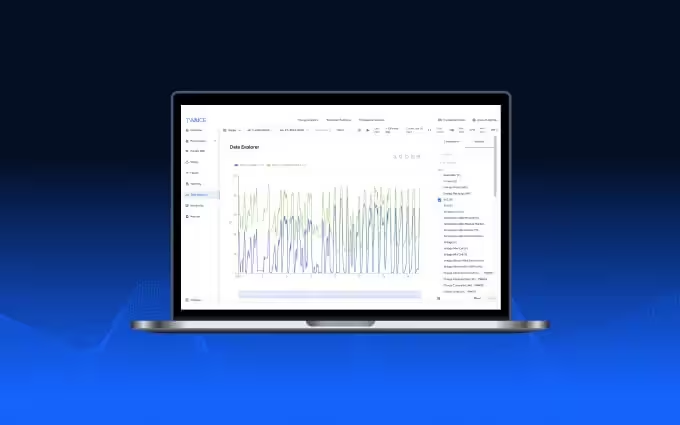Battery Energy Storage System Safety: How to Avoid the Worst Case Scenario
The lithium-ion battery market is growing fast, meaning safety incidents are likely to get more and more frequent. Battery analytics helps companies reduce the risk of battery energy storage system fires.
%2520(1).avif)
Battery Energy Storage System Safety
Energy storage systems are crucial for decarbonizing our economies, and batteries are playing a significant role in enabling energy acquired from intermittent renewable sources to be stored and to stabilize the grid. Lithium-ion batteries (LIBs) are widely used due to their high potential for providing efficient energy storage and environmental sustainability, but unfortunately, the fast-growing LIB market has seen a number of battery fires. With the expansion of grid scale battery deployment, these incidents are likely to increase further in the years to come.

Safety incidents result in severe economic issues for stakeholders involved in BESS projects, in some cases complete loss of the asset, and significantly damaging the reputation of the companies involved. Consequently, increasing attention is being paid to LIB safety issues. Companies are developing safety strategies, and governments are introducing new regulations to ensure the safety of LIBs. For example, in the US, NFPA 855 (Standards for the installation of Stationary Energy Storage System) provides minimum requirements for mitigating the hazards associated. Failure to act to ensure the safe installation and operation of BESS would therefore result in non-compliance with current regulations in addition to significant economic and reputational damage.
There are multiple factors involved in ensuring the safe operation of batteries. Their safety is determined by the battery chemistry, operating environment, and the amount of strain the battery can tolerate. The internal failure of a LIB is ultimately caused by electrochemical system instability. Therefore, anticipating the electrochemical reactions in LIBs is fundamental in assessing battery safety. Voltage, temperature and current are the major stress factors controlling the battery reactions. Battery analytics software is vital for assessing and predicting these key indicators at an early stage.
This whitepaper summarizes the many aspects of LIB safety and discusses how certain challenges can be mitigated with battery analytics.
Discussing the Problem: Causes of Battery Energy Storage System Fires
Battery safety cannot simply be assessed with one key performance indicator. A battery fire is not usually caused by one single event, but an accumulation of single events that can trigger thermal runway and cell blow-ups, at which point nothing more can be done to prevent a fire. When the battery reaches a state of thermal runway, it spirals out of control. The temperature increases continuously due to internal reactions and thus can no longer be controlled or maintained by external measurements. This leads to thermal propagation in battery energy storage systems, as fires that start in individual cells and modules spread to others.
Critical issues that can trigger thermal runway include malfunctions in battery management systems (BMS), short-circuits, dendrite growth, and lithium plating. There are, however, many more short- and long-term root causes of BESS fires which can be categorized into electrochemical, thermal, BMS, and sensor issues.
Battery Management Systems
All lithium-ion batteries have a battery management system (BMS) that continuously monitors and controls the battery operation. In addition, energy storage systems usually have an energy management system (EMS), and often an ESMS (energy storage managementsystem) that provides an overview of an entire fleet. The core functionality of the BMS is to ensure a safe operation of the BESS. It ensures, for example, that each battery cell remains within safe voltage, current and temperature boundaries during charging, discharging and open circuit.
Malfunctions
However, reality has shown that things can go wrong. A malfunctioning BMS can lead to over-charging or deep discharging of the battery, meaning that the batteries in a BESS exceed safe voltage, current, and temperature thresholds. This can result in hazards like thermal runaways or cell blow-ups, and therefore, fire. Without additional safety mechanisms in place, there is no way of stakeholders finding out about these malfunctions until it is too late and nothing more can be done to prevent them.
Lacking Vital KPIs and Trend Analysis
Battery management systems are not able to detect all reactions occurring inside cells, for example lithium plating and dendrite growth. Short circuits or a connector breakage may occur, which are extremely dangerous for batteries and can ultimately lead to a fire which can spread to other batteries within the energy storage system. Whilst a BMS can detect the outcomes of these events, there is nothing they can do to prevent them.
Despite the large financial value of battery energy storage systems, numerous BMS do not log information, have little to no access to historical data and are limited in their computing power. A BMS also lacks the view of an entire energy storage system, asits function is to control only the one cell. Whilst companies with an ESMS will have access to historical data, they provide very little trend analysis and do not provide vital KPIs such as spreads that would be vital in recognizing the long-term signs of a safety risk.
Due to their limitations, BMS and ESMS have inadequate capabilities to detect anomalies or analyze long-term trends that can affect the safety of an energy storage system. Companies involved in energy storage system projects therefore cannot rely on BMS or ESMS to guarantee the safety of their BESS and must have additional mechanisms in place.
Electrochemical
Electrochemical issues that can arise during battery operation include dendrite growth, lithium plating and increasing voltage spreads. As these cannot be detected by battery management systems, it is vital to have mechanisms in place that can detect them.
Dendrite Growth and Li-Plating
Operating batteries incorrectly, for example operating NMC batteries with high charging rates and low temperatures, can induce Li-plating at the anode and result in dendrite growth (needle-like mesh formed from metallic Li). These dendrites grow towards the cathode, ultimately reaching the cathode surface and creating a conductive path to a degree that a short-circuit is created, leading to a sudden release of energy, in the form of an explosion and a fire.
Increasing Voltage Spreads
Battery cells are similar to each other, but never 100% identical due to quality variations, hence, they behave and age differently. The different aging paths of individual cells increase the State of Charge (SoC) and State of Health (SoH)spreads in one module over time, which limits the entire module performance and increases the stress on other, remaining modules, as they need to counteract the performance reduction of other cells or modules. The BMS tries to balance out the performance differences of individual cells to improve the overall performance, but this causes increased stress for weaker cells and further heightens the risk of faster aging and safety relevant damages. This combination can therefore push the weak cells out of safe operation windows, which, over the long term, leads to a heightened risk of a safety-critical incident that can cause a fire.
Thermal
Increasing Temperature Spreads
Increasing voltage spreads due to underlying SoC imbalances and different increases of the internal resistance also leads to temperature spreads. Additionally, as the location within the module and pack or string influences the amount of cooling power which can be directed to a specific cell, temperature spreads can further increase. As the BMS tries to balance the performance, this increases the stress on weaker cells and can lead to the temperature of cells reaching un-safe levels.
Charging at Low Temperatures
High charging rates means pushing a lot of Li-ions onto the anode side of the battery in a short amount of time. At normal temperatures, the anode can soak up the rapidly arriving Li-ions and distribute them evenly, but at low temperatures, Li-ions get stuck on the anode surface and start forming metallic lithium. Such metallic lithium on the anode surface accelerates battery aging and increases safety risks as short circuits.
Sensors
Sensor Off-Sets
Current, voltage and temperature sensors can drift and regularly show some form of season- or temperature-dependency for their signal shift or accuracy. A BMS which is only looking at bare signals does not have enough or any intelligence to dive deeper into the data and discover underlying issues, since an offset might hide operation near critical safety bounds. These offsets often happen stepwise and hence can be easily observed when looking at multiple systems and taking historic behavior into account.
Summary
Safety of batteries and their aging is determined by numerous single events. Whilst each of these events usually only harms or degrades the battery a small amount, the entirety of these events leads to battery failure. For example, when the battery is frequently overcharged or operated in a very high temperature for a longer period of time.
Nevertheless, certain single events can have a large impact on battery safety and aging because of their distinctive combination of simultaneously occurring stress parameters. For example, operating the battery at low temperatures with high charging currents can lead to cell swelling, therefore increased local pressure within modules. If these stress-parameter combinations occur regularly, battery safety is jeopardized.
Proposing the Solution: Battery Analytics as a Second Layer of Safety
The many short- and long-term causes of battery fires mean that it is not an easy job to ensure the safety of battery energy storage systems. But imagine getting insight into possible safety events months before an incident occurs!
By installing a cloud-based layer of battery analytics, you can detect key incidents and trends, and make these available to any of your stakeholders, wherever they are in the world, at any time. You and your project stakeholders can detect BMS malfunctions and other issues early and solve them while they are still preventable and before they spiral out of control.
Whilst analytics cannot replace fire suppression systems, it provides an underlying mechanism to ensure safe operation and carry out preventative maintenance so that any issues can be solved before they escalate.
Solving Battery Safety with TWAICE Safety Solutions
The TWAICE battery analytics platform makes it possible to identify safety risks early. Safety Monitoring & Analytics shows a list of incidents, categorized into “critical”, “high”, “medium” and “low” to help you understand the severity. For critical and high risks, operations & maintenance teams can immediately check what the problem is.
You can receive email notifications of these incidents and integrate them into your escalation system to ensure that operations & maintenance teams can react as quickly as possible.
You can conduct further analysis within the TWAICE platform to identify possible root causes. TWAICE additionally offers professional services to carry out root cause analysis and what actions should be carried out when incidents come up.
Detecting anomalies
A vital component of battery safety involves detecting anomalies and trends outside the norm. For example, the DC Resistance histogram in Figure 5 below shows a deviation from the average distribution, which could indicate side reactions within battery cells. This can also result in high temperature spreads, which is shown in the temperature spread histogram in Figure 5, on the right. While you could be alerted via email from an overtemperature event, detecting these trends even earlier will give you additional time to notice and fix problems before they escalate.

Laying the Groundwork for Battery Safety During Battery System Design
De-risking battery energy storage systems is not only relevant during the operation phase of the BESS. It starts right at the beginning, at the development and design phase. Every cell chemistry and format have a sweet spot in which they operate. Manufacturers sell energy storage systems in multiple geographies and environments. Customers operate the systems in diverse ways. These various factors need to be considered during the design phase. By selecting the right cell, BMS configuration, thermal management during the design phase of the BESS, companies lay the groundwork for safe operations in the long term.
With battery simulation models, integrators and system engineers can virtually test different use cases and configurations to find the optimal system design to meet customer requirements and ensure safe operation. The TWAICE battery simulation models are coupled electric-thermal-aging models, providing a holistic view of battery behavior throughout the battery lifetime.
However, as regulations and markets are highly dynamic, the operation of the BESS may significantly change later, during in-life operation. Further, as discussed in previous sections, whilst components in the BESS are highly reliable, they are not reliable enough to guarantee safety. BMS systems malfunction and manufacturing issues within cells can occur in the field. These challenges showcase the need for in-life analytics to ensure safe operations and a successful business case in the long term.
Conclusion: Potential Cost-Savings of Battery Analytics
As batteries are utilized, the short- and long-term operational risks and as well the manufacturing and system design induced risks can be addressed through continuous battery analytics. Installing a cloud based second layer of safety enables companies to detect issues and trends early, meaning they can solve issues before they escalate. Battery analytics should therefore form a fundamental aspect of any BESS safety strategies.
The possible savings that can be gained by implementing battery analytics are immense. Whilst the costs of a fire are somewhat immeasurable as they depend on multiple factors including the amount of asset loss, cost of outages and repairs, as well as reputational damage, implementing a battery analytics solution could cost less than just 0.1% of the cost of the BESS2.
Ultimately, the costs incurred by deploying a battery analytics solution are minimal compared to the multi-faceted costs of a battery fire: the worst-case scenario.
Curious to learn more? Join our live demo!
Sign up for the next live group demo and learn how TWAICE can transform your BESS operations. In just 30 minutes, you’ll get a demo of key features and use cases, and engage with our product experts for a live Q&A.



.avif)
.avif)
